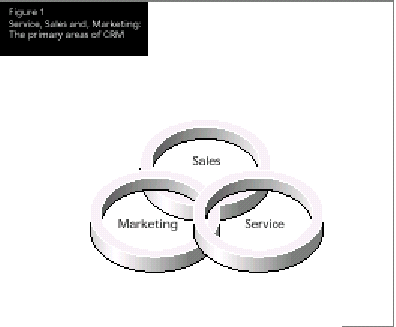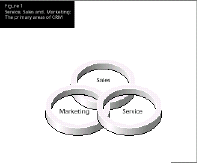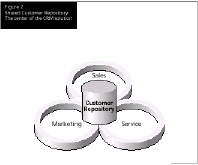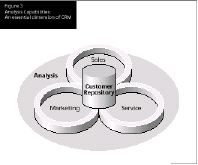|
|
 |
|
 1.2
Business philosophy 1.2
Business philosophy
|
|
 |
|
|
CRM is a catchy phrase
and sounds like a good idea. It is easy to understand and is
clearly hard to argue with. However, it is not so simple; the
concept is not so easy to implement. CRM is more than a suite
of products. CRM is a business philosophy that touches upon
many independent parts of the organization. Industry analysts
such as Gartner Group explain that top executives within the
organization must lead this new business strategy. Management
must endorse this crossdepartmental philosophy, since technology
alone is clearly insufficient.
CRM requires enterprise-wide coordination, communication, and
commitment. Successful CRM requires a new business strategy
where the enterprises policies and processes are applied to
the enabling technologies. A shift must be made from the popular
ERP systems that dominated the 1990s to focusing on the customer
and optimizing business value across service, marketing, and
sales. These new and different business skills must be
acquired and internalized before a successful CRM solution can
be implemented. The traditional notion that people buy from
people has its merit but must be expanded to a broader model
where the company backs up the individual. Tools must be supplied
to ensure that the relationship with the customer is an enterprise-wide
comprehensive task with full management commitment. The organizations
business philosophy must reflect
CRM adoption and must be clearly communicated from the upper
levels to each individual who might have any relationship with
the customer. |
|
|
 What
Does CRM Include? What
Does CRM Include?
|
|
 2.1
The major areas of CRM 2.1
The major areas of CRM |
|
There is almost uniform agreement among industry analysts
that Sales, Marketing, and Service are the three pillars of functionality
that must be addressed when putting together a CRM offering. These
are the primary areas where the customer makes contact with the enterprise,
either in a pre-sale, sale, or post sale situation, or as part of
an ongoing relationship that requires service and information as well
as the option of additional purchases. These inter-linked areas of
functionality are portrayed in Figure 1. |
|
 Service Service |
The area of service is
probably the most crucial when it comes to customer relationship
management. The customer service that an enterprise provides
is key to its ability to maintain satisfied loyal customers.
The service that is expected today goes beyond traditional telephone
call centers. Todays call centers are evolving into contact
centers handling an assortment of communication media. Telephone
interaction must be coordinated with email, fax, web, and any
other communication media that the customer prefers to use.
Self-service is a fast growing requirement, as more customers
are making their way to the web and want to look up their order
status or make queries via their browser.
Customer service clearly reaches beyond the traditional help
desk. The term "Customer Care" is being used today
to broaden the enterprises responsibility toward the customer.
Proactive relations with the customer are an important part
of what customer service is about. Customer service handles
all types of customer queries, including product concerns, information
needs, order requests, and fulfillment inquiries, as well as
providing
quality field service. |
 Sales Sales
 |
According to Meta Group, Sales Force
Automation (SFA) is the fastest growing component of CRM. The
interaction of the sales force with the prospect, turning the
prospect into a customer and then maintaining a loyal relationship,
is a core business concern for the enterprise's success. The
sales process must be managed across many domains interfacing
with other business units. Sales Force Automation is frequently
expanded to include forecasting, contact and quote management,
proposal generation, and win/loss analysis. Sales personnel
are an essential source of information for the enterprise and
must have the tools both to access up-to-date field information
and to provide this information to others. |
|
 |
Marketing
Marketing Automation includes lead generation, lead capture
and management, campaign management, and telemarketing. Today,
initial mass marketing activities are often used for the first
contact, and are then followed up by more focused campaigns
with specific target audiences in mind. Personalization is quickly
becoming the expected norm of interaction, where the customers
preferences and buying habits are taken into account. Content
management and 1:1 marketing have emerged as trends with a mission
of better addressing customers with the relevant information
for their specific needs. Marketing activities are quickly evolving
from traditional telemarketing to web and e-mail campaigns.
These web-based marketing activities give prospects a better
customer experience, allowing the relevant information to be
retrieved by the prospects on their own terms and in their own
time. For maximum value, follow-up of these campaigns must be
done in collaboration with the sales force to enable qualified
leads and success/failure analysis. Management of marketing
campaign costs as well as marketing events (trade shows and
seminars) has significant value for future planning and ROI
analysis. |
|
|
 2.2
Consistent shared customer repository 2.2
Consistent shared customer repository |
|
 |
It is insufficient for a CRM offering to independently
include Sales, Marketing, and Service. Figure 2 portrays the
shared customer repository as the entity that ties these efforts
together. These three major areas as discussed above are the
primary contact
points of the enterprise to its community. However, the lack
of a unified approach, combining and integrating these functions,
leads to less than optimal results. Integrating customer interactions
across the entire enterprise shifts organizations from departmentalized
silos of customer contact to an environment where all customer
interactions are coordinated and consistent.
Gartner Group calls the integrated approach of Sales, Marketing,
and Service applications Technology Enabled Relationship
Management (TERM). This approach modifies the way the organization
interacts with its customers. |
|
In this new paradigm,
the enterprise conforms to the customer's needs and ensures
integration of the traditionally independent activities of Sales,
Marketing, and Service. Conceptually, it is absolutely critical
and essential for a CRM solution to have the customer repository
at the center of the Sales, Marketing, and Service efforts.
An enterprise that functions with independent sources of information
has duplicate, conflicting, and out-ofdate
information. This adversely influences the effectiveness of
the enterprise as a whole. Each of the point solutions is a
step in the overall process and must communicate via a common
shared repository with the other steps in the process. |
|
 2.3
Analytic capabilities 2.3
Analytic capabilities |
|
| An important dimension
of CRM is the area of analysis capabilities, shown in figure
3, which focuses on optimizing customer value. Real-time analysis,
both quantitative and qualitative, is now being provided in
addition to standard reports that have long been an important
component of CRM solutions.Intelligent in-depth analysis requires
consistent customer data as a starting point, with all enterprise
applications participating in the analytic environment. Added
value is achieved by feeding the analysis results back to management
and throughout the organization. The enterprise decision-makers
must leverage this knowledge to make more informed and timely
business decisions. |
 |
A thorough analysis is required of
the customers to gauge the value that they bring the enterprise
as well as to measure their
satisfaction. Relevant data should be readily available and
enable intelligent insight to the underpinnings of the organization.
The
gathered information reveals, for example, customer ranking,
service-level, and critical bottlenecks. It is the basis for
management
reports and an assortment of enterprise tasks such as prioritizing
leads, monitoring time spent on certain phases of the sale cycle,
or
the types of problems that are being dealt with. Analysis tools
should allow strategic planning, enabling the appropriate allocation
of resources to where opportunity lies and the re-evaluation
or re-structuring of problematic areas. Collected demographic
information should be provided as input for more focused campaigns
to more specific target markets. More informed business decisions
can thus be carried out with the aid of analytic tools that
consolidate and manage the vast amount of customer knowledge
within the organization. |
|
|
|
|
|
|
|
|



